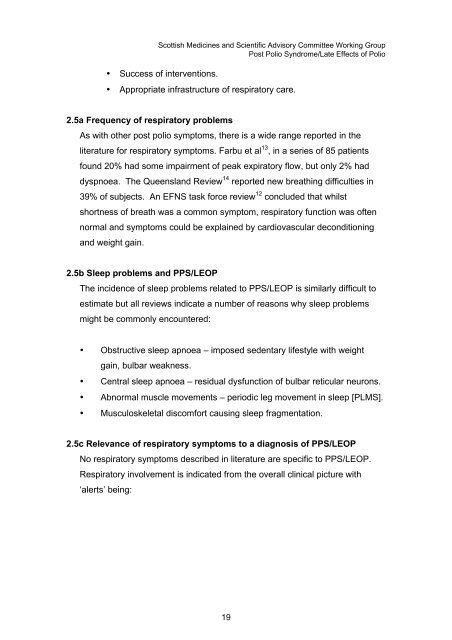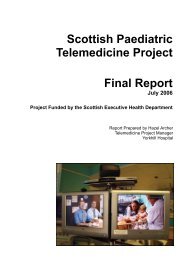SMASAC Working Group Post Polio Syndrome - Scottish Health On ...
SMASAC Working Group Post Polio Syndrome - Scottish Health On ...
SMASAC Working Group Post Polio Syndrome - Scottish Health On ...
You also want an ePaper? Increase the reach of your titles
YUMPU automatically turns print PDFs into web optimized ePapers that Google loves.
<strong>Scottish</strong> Medicines and Scientific Advisory Committee <strong>Working</strong> <strong>Group</strong><br />
<strong>Post</strong> <strong>Polio</strong> <strong>Syndrome</strong>/Late Effects of <strong>Polio</strong><br />
• Success of interventions.<br />
• Appropriate infrastructure of respiratory care.<br />
2.5a Frequency of respiratory problems<br />
As with other post polio symptoms, there is a wide range reported in the<br />
literature for respiratory symptoms. Farbu et al 13 , in a series of 85 patients<br />
found 20% had some impairment of peak expiratory flow, but only 2% had<br />
dyspnoea. The Queensland Review 14 reported new breathing difficulties in<br />
39% of subjects. An EFNS task force review 12 concluded that whilst<br />
shortness of breath was a common symptom, respiratory function was often<br />
normal and symptoms could be explained by cardiovascular deconditioning<br />
and weight gain.<br />
2.5b Sleep problems and PPS/LEOP<br />
The incidence of sleep problems related to PPS/LEOP is similarly difficult to<br />
estimate but all reviews indicate a number of reasons why sleep problems<br />
might be commonly encountered:<br />
• Obstructive sleep apnoea – imposed sedentary lifestyle with weight<br />
gain, bulbar weakness.<br />
• Central sleep apnoea – residual dysfunction of bulbar reticular neurons.<br />
• Abnormal muscle movements – periodic leg movement in sleep [PLMS].<br />
• Musculoskeletal discomfort causing sleep fragmentation.<br />
2.5c Relevance of respiratory symptoms to a diagnosis of PPS/LEOP<br />
No respiratory symptoms described in literature are specific to PPS/LEOP.<br />
Respiratory involvement is indicated from the overall clinical picture with<br />
‘alerts’ being:<br />
19



